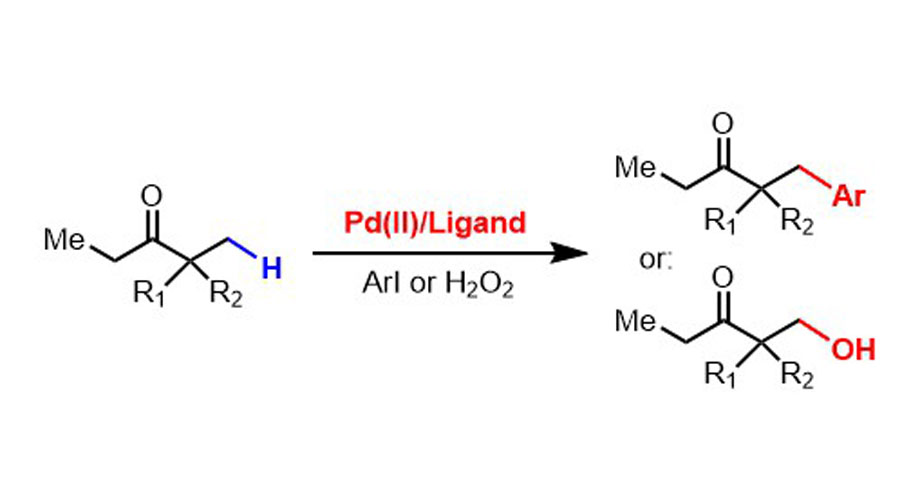
The first catalyst for C-H activation of ketones. Credit: Scripps Research
Scripps Research chemists unlock the potential of ketone and ester molecules, paving the way for greener and more efficient drug development
New findings reveal a technique to transform essential chemical building blocks for drug discovery and beyond—representing the “final step” in applying this method to all key classes of organic molecules.
January 08, 2025
LA JOLLA, CA—Scientists have long considered ketones (a fundamental chemical class) and esters (molecules formed when an acid reacts with an alcohol) to be locked treasure chests of possibilities. Ubiquitous as pharmaceutical intermediates, ketones and esters are widely used for the synthesis of drug molecules. Yet both share a critical limitation: Generally, only two specific sites within their structure—the carbonyl carbon and the alpha position—are easily accessible to conventional chemical reactions. The remaining carbon sites are protected by stable carbon-hydrogen (C-H) bonds that don’t readily interact with catalysts—substances that speed up chemical reactions and allow scientists to alter molecular structures. Thus, the C-H bonds make it difficult to modify ketones and esters. But now chemists at Scripps Research have uncovered the key to unlocking these molecules’ untapped potential.
Their findings, published in Nature on January 8, showcase a novel method that simplifies and expands the use of ketones and esters without the need for additional chemical steps. By overcoming the resistance of ketones and esters to chemical modification, the research team’s breakthrough has implications for faster and more sustainable chemical production.
“Ketones are the bread and butter of chemical synthesis, which is the process of building new, complex molecules from simpler ones,” says senior author Jin-Quan Yu, PhD, the Frank and Bertha Hupp Professor of Chemistry and the Bristol Myers Squibb Endowed Chair in Chemistry at Scripps Research. “They’re foundational yet underutilized because certain reactive sites were essentially inaccessible until now. Esters are also crucial to drug development, making their efficient modification important for pharmaceutical innovation as well.”
This new approach for accessing ketones and esters builds on years of developing methods to transform traditionally unreactive bonds into useful chemical tools. For more than a decade, Yu has been at the forefront of C-H activation, a process that allows chemists to more easily break strong C-H bonds and reconfigure molecules in precise ways. By using special catalysts, scientists can "activate" this bond, allowing them to add new atoms or groups to molecules.
Yu’s lab has already pioneered methods to unlock similar bonds in acids, alcohols and amines, three other major chemical groups critical to drug synthesis. The new method with ketones—and to an extent, esters—marks the final step in a quest to expand this powerful approach to all key classes of organic molecules.
Despite ketones and esters playing a central role in synthesis, their low affinity for metal catalysts has long posed a challenge for chemists attempting to activate inert C-H bonds.
“C-H bonds are incredibly strong, and the natural structure of ketones and esters makes it especially difficult to direct a catalyst to the desired site,” explains Yu.
Ketones and esters have a low affinity to metal, so they don’t bind well to catalysts. Furthermore, their C-H bonds are very strong and resist transformation. This paradox has frustrated scientists for decades, forcing them to use cumbersome extra steps—like attaching chemical “directing groups”—to modify these molecules and guide catalysts to the right spot. But this approach added waste to the process.
Yu and his team solved this challenge by designing a unique catalyst system. At its heart is a specially crafted molecule called the monoprotected amino neutral amide ligand, which helps palladium—a common catalyst—bind to ketones and esters more effectively. Paired with a strong acid called tetrafluoroboric acid, this setup stabilizes the catalyst just long enough to break the C-H bonds in both ketones and esters, opening them up for modifications.
Using this approach, Yu and his team were able to induce chemical reactions (such as arylation and hydroxylation) that add key building blocks to molecules to make them more functional. Such modifications could streamline drug production and help with tailoring specialized chemical compounds, as they allow scientists to create more intricate and biologically relevant molecules—without the multistep processes typically required.
“This approach not only give ketones and esters a new life in synthesis, but it also expands the possibilities for creating molecules with greater precision and functionality,” notes Yu.
Because this method streamlines the production of key pharmaceutical compounds, it makes the process quicker, cheaper and more environmentally friendly. By simplifying ketone transformation, Yu’s approach reduces chemical waste and aligns with the broader push toward greener chemistry.
But the impact of this research extends past the pharmaceutical industry. Beyond drug discovery, the findings have implications for materials science, agrochemicals and even the production of everyday items like plastics and solvents.
“Ketones are everywhere—from durable resins to the acetone in nail polish remover,” says Yu. “Similarly, esters are key ingredients in drugs like aspirin, and as well as in fragrances, flavors and even biodegradable plastics.”
Yu’s next goal is to adapt his new system to create chiral molecules (chemical compounds made of the same parts but arranged as mirror images of each other)—an essential step in producing many pharmaceutical products.
“This method doesn’t just expand what we can do with ketones and esters,” says Yu. “It unlocks a new dimension of chemical synthesis, one that connects simpler materials to more complex, valuable structures.”
In addition to Yu, authors of the study, “β-C−H bond functionalization of ketones and esters by cationic Pd complexes,” include Yi-Hao Li, Nikita Chekshin and Yilin Lu of Scripps Research.
This work was supported by funding from the National Institute of General Medical Sciences (grant 2R01GM084019).
For more information, contact press@scripps.edu

